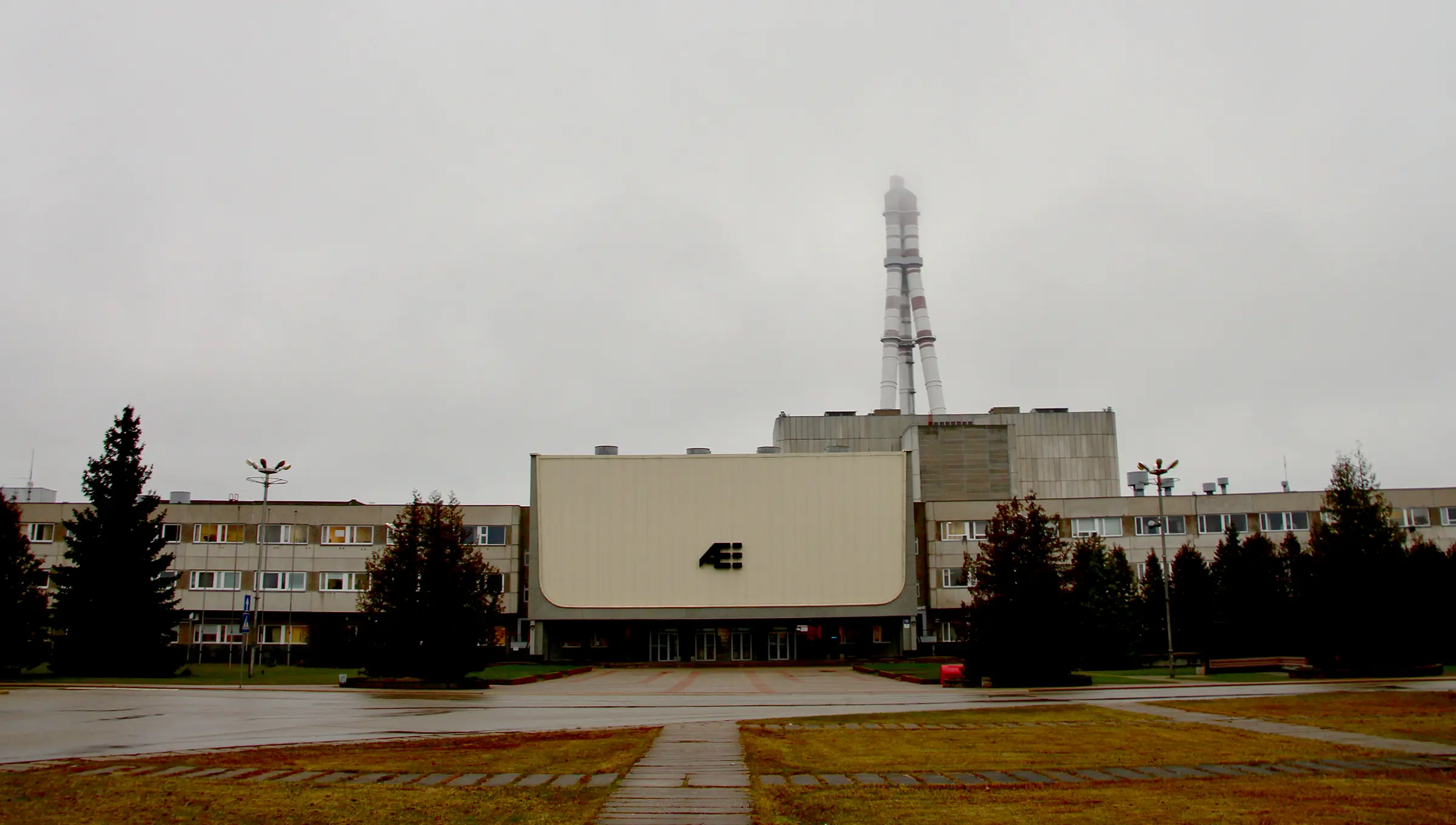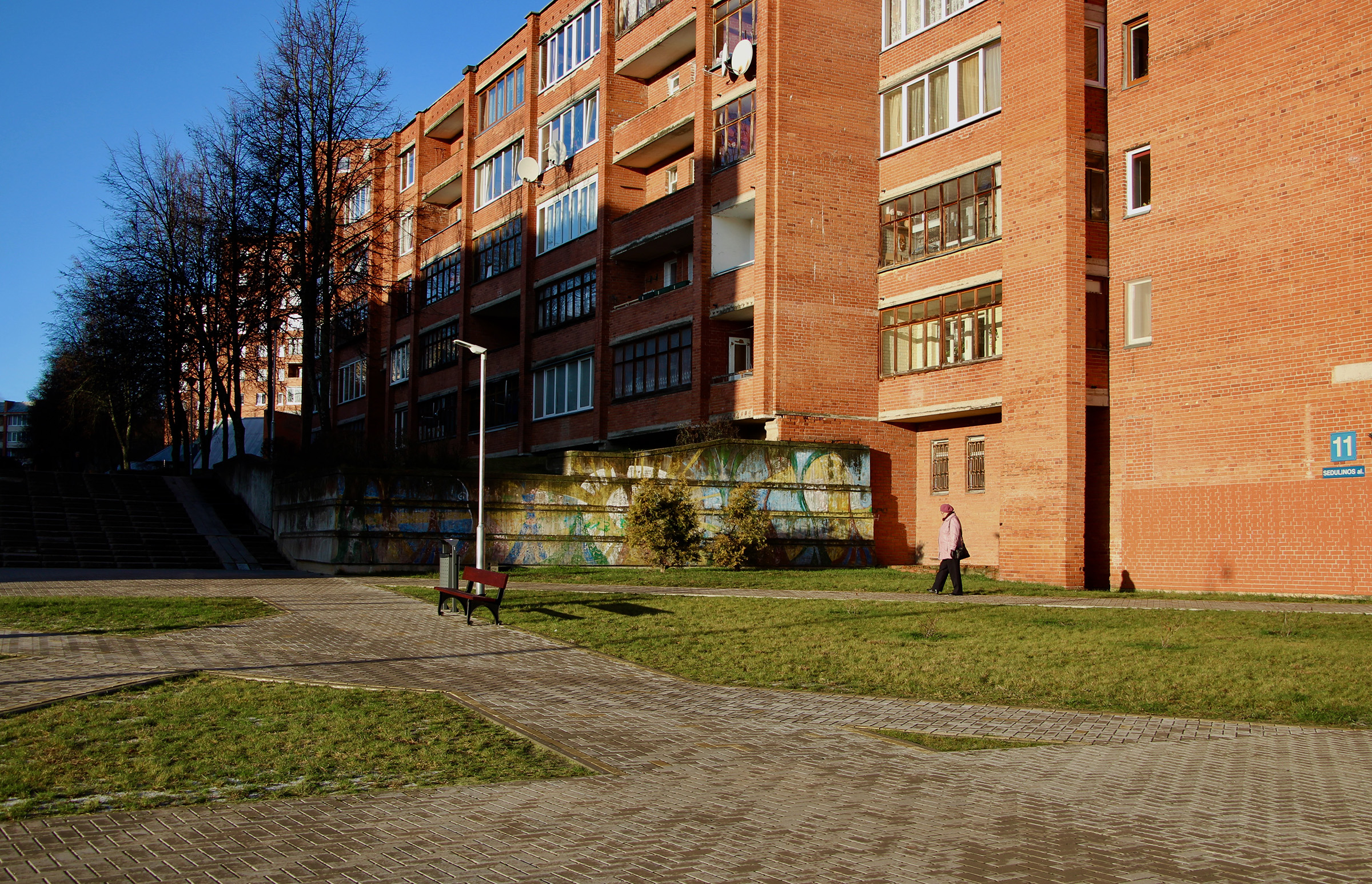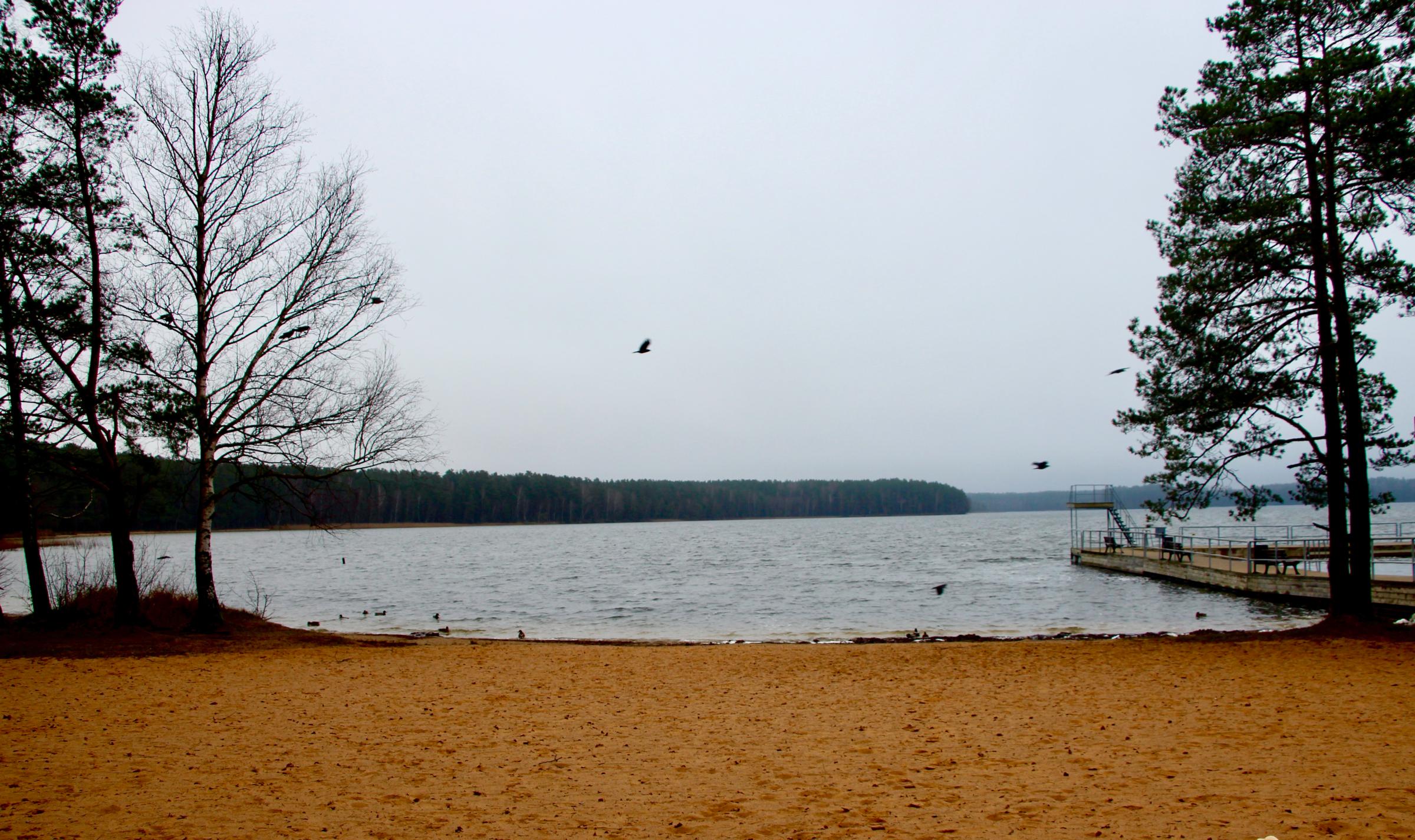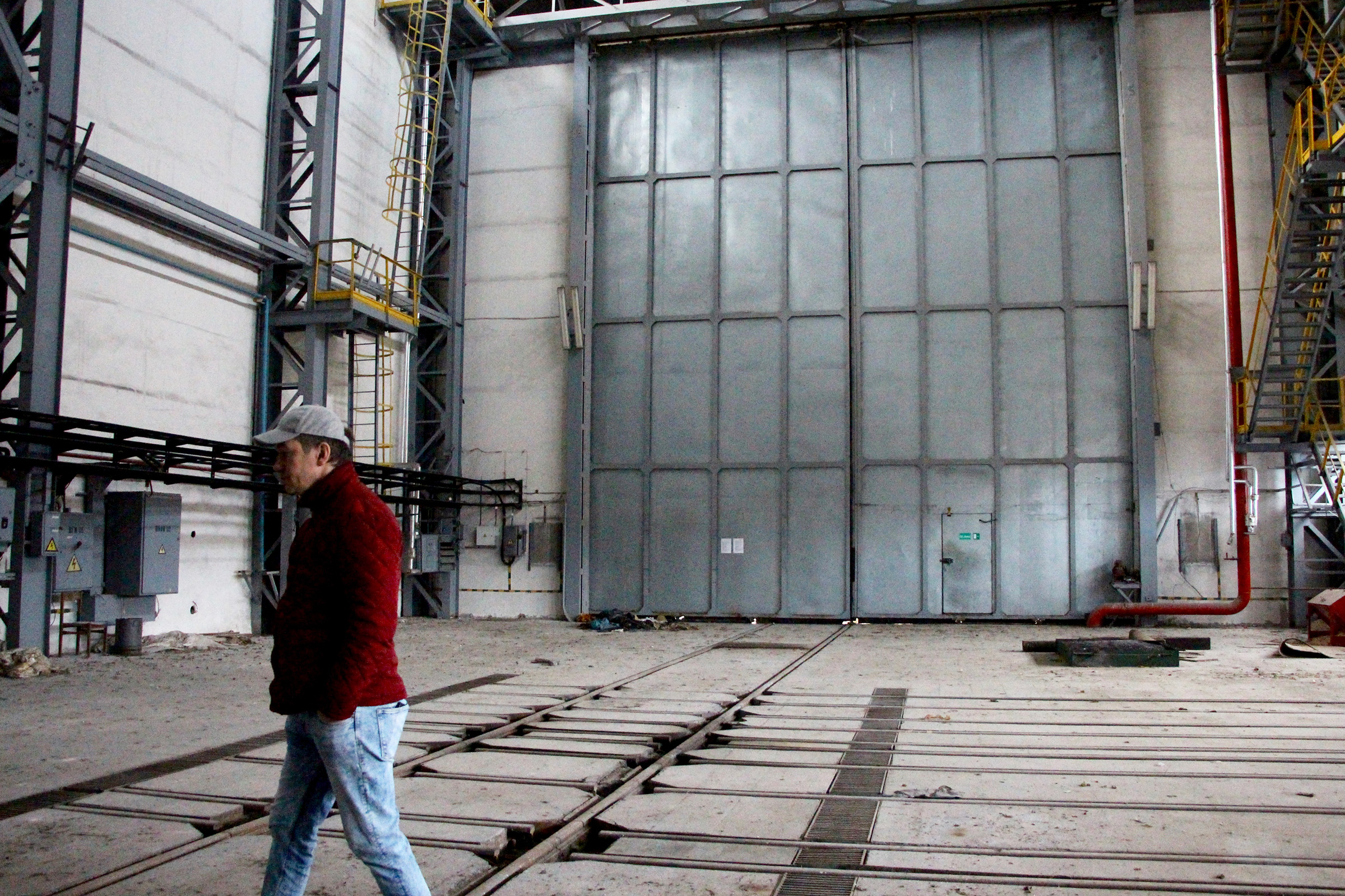Wearing a white cotton bodysuit, a helmet and a respirator to protect against radiation, tour guide Beata Jevsejeva walks briskly up the stairs to the reactor hall at the decommissioned Ignalina Nuclear Power Plant (INPP) in the Lithuanian town of Visaginas. It’s late November and sparks fly out of the ground as mechanics saw metal to remove a refueling machine, once used to top up uranium levels. Ten years ago, on Dec. 31 2009, the INPP’s final nuclear reactor was shut down shortly before midnight. By 2038 the entire plant will be dismantled.
The room will look familiar to anyone who’s watched the HBO Chernobyl series, which was filmed at the Ignalina power plant in August 2018. The hugely popular series, watched by over 8 million people, shows the catastrophic nuclear explosion at the Chernobyl nuclear power plant near the town of Pripyat in Ukraine in 1986. Current estimates place the number of deaths between 4,000 (according a 2005 United Nations analysis) and 90,000 (as suggested by Greenpeace International). Since the series was released in May, tourism to Ignalina has “massively increased,” says Natalija Survila-Glebova, head of communications at INPP.
That’s partly because, more than 30 years on, Chernobyl’s radiation levels remain too high for tourists to walk around the plant. Instead, tourists from around Europe, the U.S. and Australia have poured into the Ignalina plant in Visaginas for the unique experience of being able to walk on nuclear reactors, something that’s too dangerous to do in Chernobyl. Tickets to tour the Ignalina plant, priced at 60 euros ($66) each, are booked up months ahead. In 2019 alone, 4,025 people visited the plant, says Survila-Glebova.
The rise in tourism has breathed new life into a town that has faced an identity crisis since the Ignalina plant was decommissioned in 2009. The closure led to the loss of thousands of jobs and a surge in young people leaving Visaginas; Survila-Glebova says that the plant will be fully closed off in eight years. The mayor and residents are instead finding ways to move the town away from its nuclear identity and develop other industries to keep people from leaving, and to attract more visitors. “Our city will always be a nuclear age monument, but it will not support the life of our residents,” says Pavel Kostenko, a 36-year-old Visaginas resident who runs a small steel production company, Viri Technologija.

Situated among pine forests and on the shores of the Visaginas lake, some 80 miles from the capital Vilnius, the town of Visaginas was built in 1975 to accommodate plant workers. Technicians and nuclear physicists came from around the USSR and then-Communist countries like Poland; they were housed along 14 streets in this town with an area of 5.6 miles. By 1983, people of 43 different nationalities had built one of the world’s most powerful nuclear power stations, providing 70% of Lithuania’s electricity and pumping energy throughout the Baltics and Russia. “It was intended to be a window of Soviet progress to the West,” says Olga Cernovaite, who directed the 2017 documentary Butterfly City, shot in Visaginas. (Seen from the air, Visaginas’ design resembles a butterfly cut in half, with each wing representing the INPP reactors.)
But a lot has changed since the Soviet Union fell in 1991, cutting off the flow of money from Moscow. The newly-independent, cash-strapped country of Lithuania sought to join the European Union. Attached to the conditions for its accession was the dismantling of the Ignalina plant due to safety concerns. Ignalina’s reactors were three times as powerful as the RBMK reactors in Ukraine’s infamous Chernobyl plant. In 2004, Lithuania became an E.U. member; with that came a multi billion euro package to close the plant. But in doing so, the country lost a major export commodity and is now dependent on 73% of its energy being imported (well above the E.U. average of 52%) from Norway and the United States.
Launching and expanding new industries is now seen as a way of connecting more closely with other parts of Lithuania. In this mostly Russian-speaking town, where more than half of the population are Russian, many residents have felt disconnected from the rest of the country. “We were living in the past, now we need to think about the future,” Kostenko says.
The closure of Ignalina, which began in 2004, was a huge shock to the country. “No one could believe they would do that and cut thousands of jobs,” says Kostenko, whose parents, now retired, were INPP engineers. Some 5,000 people were employed at the plant; today, only about 1,900 are left, according to Survila-Glebova.
The town has also shrunk. Over the past 20 years, a third of the population, mostly young people, have migrated to Russia and other cities in Europe; the town is now home to about 18,700 people, with an average age of 55, according to Visaginas mayor Erlandas Galaguz. “There was an identity crisis. The city was built for the plant. Without the plant, there is no city,” says Galaguz, who worked as a reactor engineer for over a decade. “Residents thought that there won’t be life here.”
The crisis was compounded by the language barrier. “To be Lithuanian you need to speak the language,” says documentary producer Cullinane. Many people from Visaginas’ older generation can’t speak Lithuanian and that “doesn’t go over so well” in modern Lithuania, Cullinane adds.
“Life in Visaginas was like a bubble and when it burst, the town began searching for its identity. This is something that is probably happening in many former Soviet republics—not just in Visaginas,” says Cernovaite, the Butterfly City director. Under Soviet rule, Moscow’s policies of Russification — the spreading of Russian culture and language throughout the republics — sought to control a diverse population by suppressing ethnic national identities. The strength of national identity varied across Soviet states. But in Lithuania and their Baltic neighbors Latvia and Estonia — the last states to join the USSR and the first to leave — it was strong.

Many residents of Visaginas have said they’re disappointed with how the Lithuanian media tends to portray the town. When Russian President Vladimir Putin annexed the Ukrainian peninsula of Crimea in 2014, under a pretext of safeguarding Russians and Russian speakers, several Lithuanian outlets grew suspicious of Visaginas. In March 2016, a major news platform in the Baltics described Visaginas as a threat to Lithuania’s security. The headline claimed that the homeland security department had found an active “death battalion” in Visaginas, which turned out to be teenagers playing with air guns and wearing old Soviet military uniforms that belonged to their grandparents.
Even residents who are fluent in Lithuanian have struggled to integrate. Speaking through her respirator in a muffled voice as we walk through a long, brightly lit corridor Jevsejeva says: “I understand, talk and work in Lithuanian and with Lithuanians, but unfortunately I don’t feel fully Lithuanian, and other Lithuanians don’t recognize me as one of them.” The 31 year old worked in London at two major banks for four years before deciding to move back.
“I thought I would die of loneliness in London,” she says, adding that she’s one of a handful of her classmates who decided to settle in Visaginas, where the average salary is 700 euros a month.(The national average is 1,300 euros.)
“We need to go back to a state where people believe in the town’s perspective and potential,” says Visaginas mayor, Erlandas Galaguz. And to do that, he says, Visaginas needs jobs. “But things are getting better,” he adds. A new factory that will produce medical equipment is currently being built by the U.K. based Intersurgical in Visaginas, to be launched next year. It’s expected to give an economic boost to the town, with the factory planning to employ about 200 people initially and to eventually increase the workforce to 1,500.
Another potential area for development is ecotourism, because Lithuania has rich national parks, coastal scenery, lakes and rivers. In January 2018, Visaginas residents Anton Jevtiuchov, 28, and his wife Anastasija, 27 launched a Visaginas-based travel company, LitWild Travel, organizing daily and weekly trips around Lithuania’s lakes and forests. They had previously studied and worked in recruitment and engineering in the U.K., Spain and Russia, before returning home to set up the company. Last year, they conducted 86 tours with up to 30 participants, most of which start in Visaginas or in nearby towns. That work earned them a “Heroes Among Us” award from the President of Lithuania last January, given to Lithuanians who return home after living abroad to start their own civic initiative.

LitWild has been able to bring in visitors, Anastasija says, because of improvements in infrastructure in Visaginas. These new pavements, street lights and regular trains connecting the town to the capital are largely the result of E.U. funds from 2007-2013. But she says the company needs more support. “At the moment, it’s all in our hands. Our business, like other local businesses, needs more support from local authorities,” says Anastasija. LitWild wants to set up a local camping site and an information center, which require a greenlight from local politicians. But Anastasija says they’ve been waiting for concrete action for over a year.
Residents are also keen to develop the creative industries. Alex Urazov greets me with a smile outside his art residency “Tochka” (“Point”) in central Visaginas, barefoot and in cut-off cargo pants even though it’s snowing. The 35 year old was born in Russia and moved to Visaginas in 1988 at the age of 4, when his parents found work at the plant. Twenty years later, when Urazov was working as a DJ, he says he felt he had “hit a ceiling” and needed to get out. That’s when he moved to Britain, spending time in London and Leeds. “Work, drink, party and the cycle continues. A destructive time,” he says. After four years of life in the U.K. he moved back to his hometown to set up an art residency. “I found my purpose,” he says.
Tochka, which occupies a 5 story building in the center of town, welcomes young Visaginas residents and visiting artists. Urazov’s only rule is that alcohol and drugs are banned. “I won’t turn them away if they come here drunk, but they can’t take anything in here,” he says. Tochka looks like a big bric-a-brac shop. Masks, sci-fi figurines and other crafts — some made by the visitors — crowd the dimly lit rooms. One of the rooms is decked out in dream catchers and hand-made key-chains, which they sell online and at local markets. At Tochka, people draw on the walls, engage in heated debates or read Urazov’s collection of books on philosophy. It’s also a rare safe space in Visaginas for LGBT people. “A lot of people who don’t feel like they fit in come here,” he says.
Urazov says he wants Visaginas to move away from its “Soviet” past and become more “European.” “I want to bring Lithuania and the world closer to Visaginas, attract diverse people and make it contemporary,” he says. Various artists and photographers have begun migrating from the capital to Visaginas, according to Urazov, because “property is cheap, it’s peaceful with the surrounding nature and has all the necessities of a city.”
Other residents see a huge potential in the plant’s leftover infrastructure. One afternoon, Kostenko and Igor Davidyuk, a member of the city council, drive to a large 3-story administrative building in the Ignalina power plant that’s been abandoned and closed off to the public since 2009. As we pull up to the rusted gates, Kostenko proudly shows me a frame from the Chernobyl trailer featuring this exact gate and tells me how camera crews took over the site for four days.
But attracting more production companies is not what they have in mind for the future. Davidyuk, a member of the “Visaginas is Us”, a public election committee led by seven other young professionals from the town, envisions Visaginas as an IT hub that hosts data centers—and hopes to transform the Ignalina power plant facilities into a data center.

Lithuania has become increasingly attractive to both technology companies and businesses that need tech expertise. It is home to 13 of the 20 largest IT companies in the Baltics, has Europe’s fastest and most affordable internet connection, and a highly developed IT infrastructure. In 2015, Google established a sales office and Nasdaq, an American stock exchange, opened a center of excellence in Vilnius.
“Visaginas is Us” says politicians in Vilnius could help the town attract investors and encourage companies to expand by introducing a free economic zone in Visaginas (an area where companies are taxed very lightly or not at all) or by offering corporate tax concessions. In 2019, they secured the lifting of the sanitary protection zone, which bans certain businesses operating within a 2 mile radius of the plant. The relaxed restrictions, expected to be implemented from January 2020, will allow businesses to set up shop in this building and six others around the plant.
If successful, the administrative buildings in the Ignalina plant wouldn’t be the first former nuclear facility to be transformed into a data center. In 2008, a building that was part of an ex nuclear plant in Hanau in central Germany was turned into a data center by 1&1 Internet, one of the world’s largest web hosting companies. By 2021, Rostelecom Data Centres, Russia’s largest digital service provider will launch commercial services in a disused plant in the western Russian city of Tver. And a former Google executive suggested in 2016 that a defunct power station in Vermont be used as a data center.
In one of the building’s rooms at Ignalina, old fire extinguishers and barrels of oil are scattered on the ground, and a large industrial hook hangs from the ceiling. A railway track, once used to transport materials, runs through the room and around the Ignalina plant; “the plant’s artery” is what Kostenko calls it. Old signs that read “Danger! Keep out” hang below red rubber gloves coated in white dust. In a room that occupies the entire third floor, a few shelves are stacked with files, and black and white photos of former plant employees. “Think how many offices and people could be here,” says Kostenko. “So much potential”.
On the roof, we get a view of hundreds of yards of the Ignalina plant, its dozens of remaining electrical grids, and even more foundations of those that were dismounted. “If we could only get the young generation to build something as big and impressive in such a short amount of time as the older generation did,” says Kostenko, “the town will do well.”
Correction, Jan. 3
The original version of this story misstated the number of deaths caused by the Chernobyl explosion. Current estimates place the number of deaths between 4,000 (according a 2005 United Nations analysis) and 90,000 (as suggested by Greenpeace International), not 40,000.
Correction, Dec. 30
The original version of this story misstated the name of INPP’s head of communications. Her name is Natalija Survila-Glebova, not Natalija Kravchenko.
More Must-Reads From TIME
- Dua Lipa Manifested All of This
- Exclusive: Google Workers Revolt Over $1.2 Billion Contract With Israel
- Stop Looking for Your Forever Home
- The Sympathizer Counters 50 Years of Hollywood Vietnam War Narratives
- The Bliss of Seeing the Eclipse From Cleveland
- Hormonal Birth Control Doesn’t Deserve Its Bad Reputation
- The Best TV Shows to Watch on Peacock
- Want Weekly Recs on What to Watch, Read, and More? Sign Up for Worth Your Time
Contact us at letters@time.com